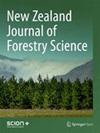Effects of selective-logging, litter and tree species on forests in the Peruvian Amazon: seed predation, seed pathogens, germination
IF 1.1
4区 农林科学
Q2 FORESTRY
引用次数: 1
Abstract
Background: The Amazon basin contains mainly unflooded forests, and they are among the most important ecosystems in the world. Field experiments on seed processes are very important in order to understand the structure, function and dynamics of these forests. Methods: And so tree seeds of three species (Cecropia latiloba, Guarea macrophylla, Socratea exorrhiza) were set out in Amazon unlogged terra firme forest, in Amazon selectively-logged terra firme forest, in Amazon palm forest, and in Amazon white sand forest either on top of or beneath the litter layer, and after two weeks scored for seeds taken by predators, seeds destroyed by pathogens and seeds that germinated. Results: I found both terra firme forests (unlogged and selectively-logged) lost most of their seed to predators and the least of their seed to pathogens, white sand forests lost the least of their seed to predators and the most of their seed to pathogens, and the fewest seeds germinated in both terra firme forests and in palm forest. More specifically (1) within unlogged terra firme forest addition of litter reduced seed predation but increased seed losses to pathogens and germination, and C. latiloba lost the most seeds to pathogens, (2) within selectively-logged terra firme forest seeds showed the same trends as unlogged terra firme forest but without significant effects, (3) within palm forest addition of litter reduced predation but increased losses to pathogens, and S. exorrhiza lost the least seeds to pathogens, and (4) within white sand forests addition of litter increased germination. Combining the results from all forests together, predators took most of the seeds, pathogens took most of the seeds that escaped predation, and most of the seeds that survived predation and pathogens germinated. Conclusion: While such large losses of tree seed to predators and pathogens in these unflooded forests suggest limited recruitment, the variation demonstrated in these field experiments – among forest-types, among tree species, between litter situations on the forest floor – help to insure that recruitment does occur and that these unflooded forests continue to dominate the Amazon basin.选择性采伐、枯枝落叶和树种对秘鲁亚马逊森林的影响:种子捕食、种子病原体、发芽
背景:亚马逊盆地主要包含未被淹没的森林,它们是世界上最重要的生态系统之一。种子过程的田间实验对了解这些森林的结构、功能和动态是非常重要的。方法:将3种树种(Cecropia latiloba、Guarea macrophylla、Socratea exorrhiza)的种子分别放在亚马逊未砍伐的原生地、亚马逊选择性砍伐的原生地、亚马逊棕榈林和亚马逊白沙林的凋落物层上和下层,并在2周后对被捕食者捕获的种子、被病原体破坏的种子和发芽的种子进行评分。结果:我发现两种原始林(未砍伐和选择性砍伐)的种子都被捕食者丢失,而被病原体丢失的种子最少;白沙林的种子被捕食者丢失的种子最少,被病原体丢失的种子最多;原始林和棕榈林的种子发芽量都最少。更具体地说,(1)在未采伐的阔叶林中,添加凋落物减少了种子的捕食,但增加了种子对病原体和萌发的损失,其中松木的种子损失最多;(2)在选择性采伐的阔叶林中,种子的趋势与未采伐的阔叶林相同,但没有显著影响;(3)在棕榈林中,添加凋落物减少了种子的捕食,但增加了对病原体的损失,而阔叶林的种子损失最少。(4)在白沙林中添加凋落物可提高萌发率。综合所有森林的结果,捕食者带走了大部分种子,病原体带走了大部分逃脱捕食的种子,而大多数在捕食中幸存下来的种子和病原体都发芽了。结论:在这些未被洪水淹没的森林中,如此大量的树木种子流失给捕食者和病原体,这表明种子的补充是有限的,而在这些野外实验中显示的变化——在森林类型、树种之间、在森林地面上的凋落物情况之间——有助于确保种子的补充确实发生,这些未被洪水淹没的森林继续主导亚马逊盆地。
本文章由计算机程序翻译,如有差异,请以英文原文为准。
求助全文
约1分钟内获得全文
求助全文
来源期刊

New Zealand Journal of Forestry Science
FORESTRY-
CiteScore
2.20
自引率
13.30%
发文量
20
审稿时长
39 weeks
期刊介绍:
The New Zealand Journal of Forestry Science is an international journal covering the breadth of forestry science. Planted forests are a particular focus but manuscripts on a wide range of forestry topics will also be considered. The journal''s scope covers forestry species, which are those capable of reaching at least five metres in height at maturity in the place they are located, but not grown or managed primarily for fruit or nut production.
 求助内容:
求助内容: 应助结果提醒方式:
应助结果提醒方式:


